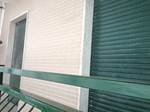Planefibra embraces a movement aiming to reposition GFRP tiles in Brazil
Recent prejudices threaten to undermine the product’s ESG benefits, which Planefibra is taking steps to negate.
Planefibra (Santa Catarina, Brazil) is making a series of moves in industry to help reposition the prejudice of low quality against fiberglass-reinforced plastic (GFRP) tiles. While the tiles are trending in Brazil — mainly because of their translucency, which enable the use of natural light — this popularity has not prevented them from suffering some damage to their image in recent years.
“A negative experience is reproduced hundreds of times, while the positive one almost always falls into oblivion,” says Cyrus Muchalski, director of Planefibra. The company has been manufacturing GFRP tiles and domes for natural lighting and ventilation for almost 20 years. “There are 70,000 applications of this material cataloged around the world, many of them involving high performance, such as aircraft, F1 cars, satellites, bridges and submarines. Therefore, it makes no sense to classify it as a low-performance materia.”
To help reposition GFRP tiles, Planefibra does its homework, consistently producing only under ABNT NBR 16753 standards. “We actively participate in the committee responsible for reviewing this standard,” Muchalski says. With a minimum useful life of 10 years, Planefibra tiles have a 5-year factory warranty.
In parallel, the company has sought to further improve its tile offerings, such as including a polyester film with ultraviolet (UV) protection on both sides of the tile as a standard finish and at no additional cost, further increasing mechanical resistance. A most recent technology development added thousands of prisms in the GFRP that will give rise to the tiles. “Prismatic products can increase the use of natural light by 30%,” Muchalski says. “And all of this at a price around 40% lower than that of polycarbonate tiles, the main competitor of GFRP in translucent coverings.”
Another Planefibra activity in favor of the tile image is its active participation in the Civil Construction Committee of the Latin American Composite Materials Association (ALMACO), an entity that represents the entire production chain of GFRP.
“Among other actions, we are collaborating with the production of a guide for GFRP applications in the construction industry,” summarizes Muchalski. “This publication will help not only to show the versatility of the material but also to demystify some prejudices.” According to ALMACO, the guide will be launched in August.
Related Content
-
Plant tour: Teijin Carbon America Inc., Greenwood, S.C., U.S.
In 2018, Teijin broke ground on a facility that is reportedly the largest capacity carbon fiber line currently in existence. The line has been fully functional for nearly two years and has plenty of room for expansion.
-
Natural fiber composites: Growing to fit sustainability needs
Led by global and industry-wide sustainability goals, commercial interest in flax and hemp fiber-reinforced composites grows into higher-performance, higher-volume applications.
-
The potential for thermoplastic composite nacelles
Collins Aerospace draws on global team, decades of experience to demonstrate large, curved AFP and welded structures for the next generation of aircraft.














.jpg;maxWidth=300;quality=90)


